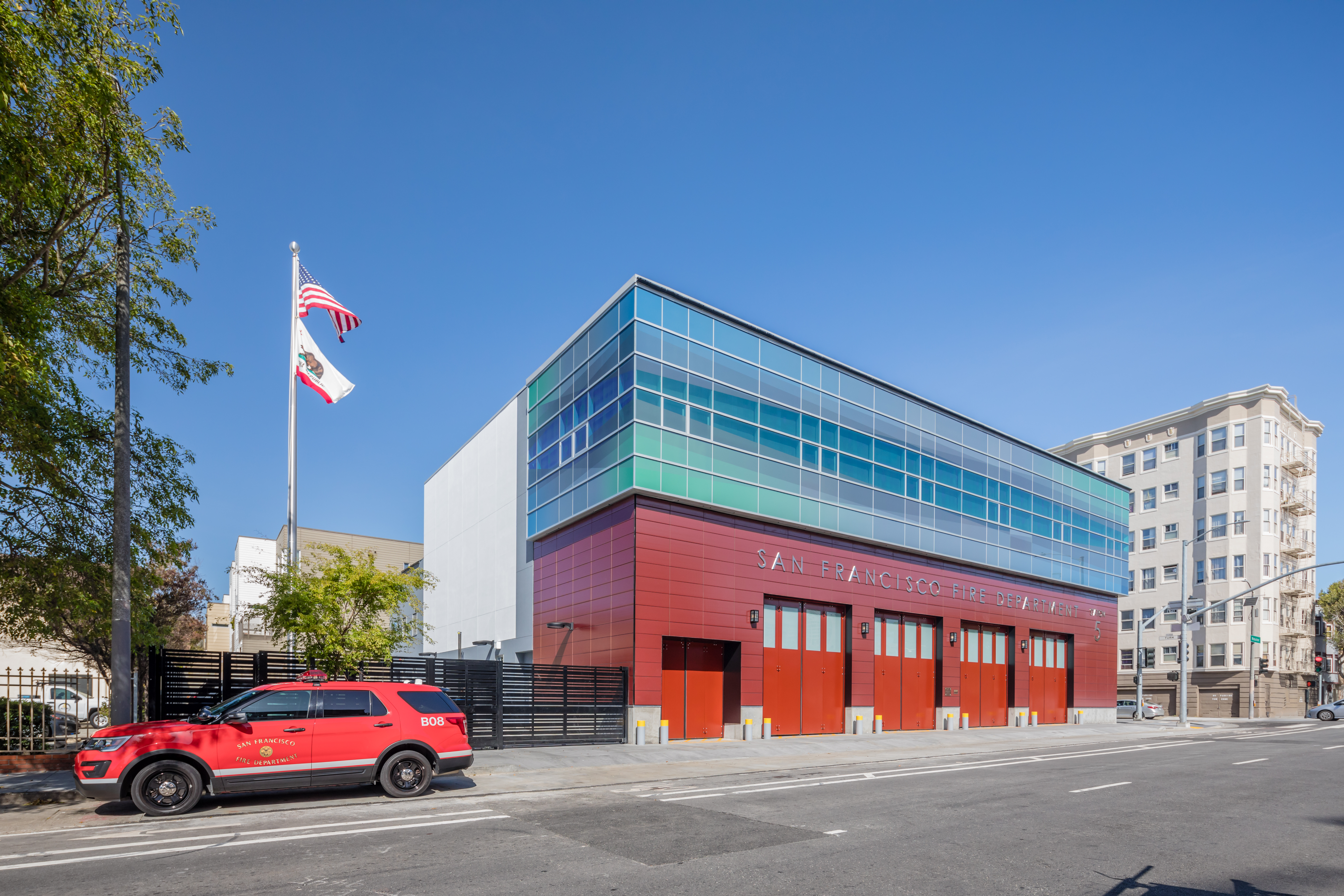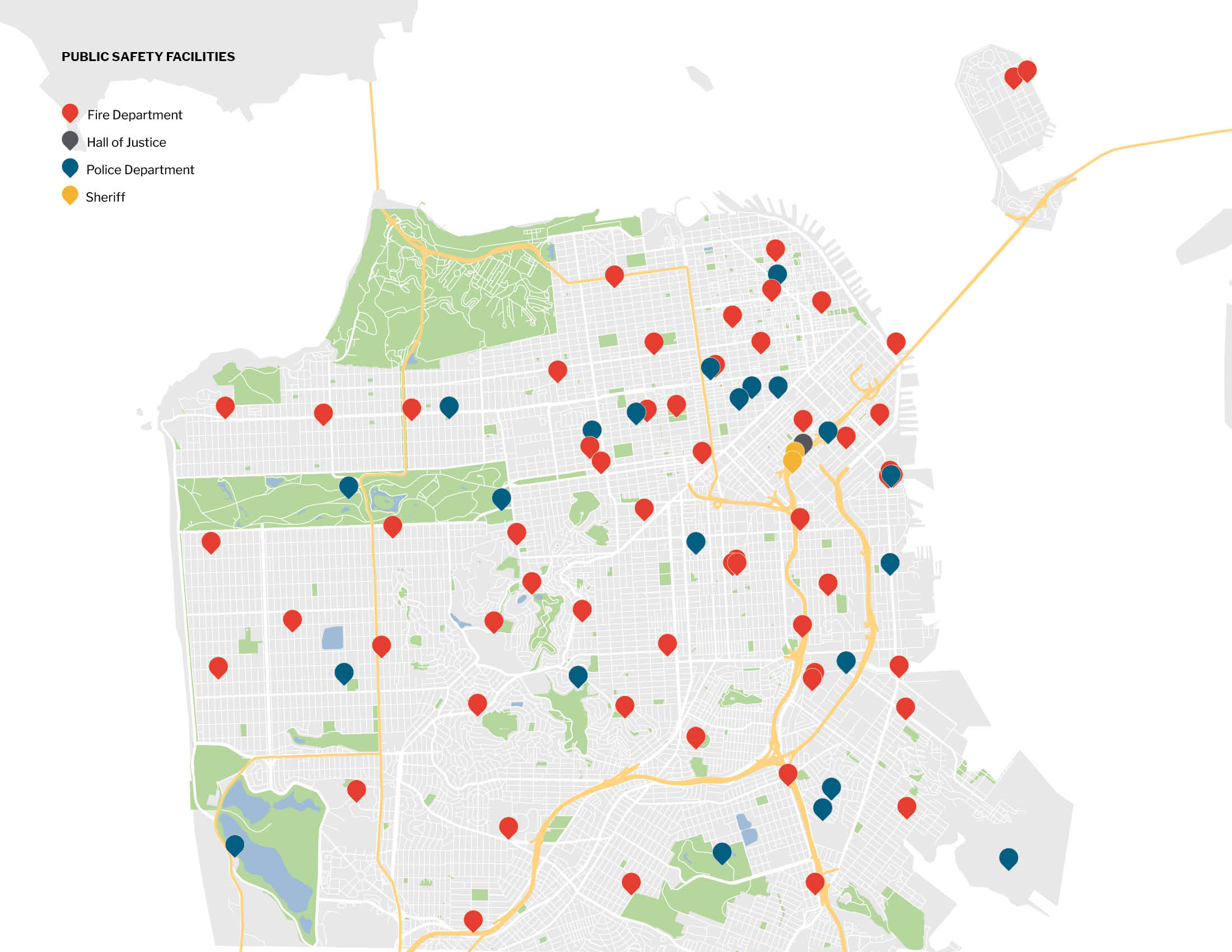DEM: Department of Emergency Management
FIR/SFFD: Fire Department
JUV: Juvenile Probation Department
POL/SFPD: Police Department
SHF: Sheriff’s Department
APD: Adult Probation Department
DA: District Attorney’s Office
PD: Public Defender’s Office
The Public Safety Service Area addresses the capital needs of the agencies working to keep San Franciscans safe and secure in their daily lives and in response to emergency situations. From fire and police stations, to jails and juvenile detention facilities, to evidence storage and forensic lab space, public safety facilities have unique needs for their highly specialized operations. Maintaining the infrastructure that enables public safety departments to do their jobs safely, day in and day out is one of the primary challenges of the Capital Plan. To ensure the security and well-being of San Francisco’s visitors and residents, including those in custody, the City must devote resources to provide humane and resilient facilities for our public safety agencies.
Overview
Neighborhood fire stations and support facilities, district police stations and related facilities, County jails, 911 call center, emergency firefighting water supply system, and court-related agencies such as the District Attorney, Public Defender, and Adult and Juvenile Probation are all important in providing public safety services. While significant facility and infrastructure needs remain, the City has provided more funding for these facilities over the past 12 years compared to any period.
Earthquake Safety and Emergency Response (ESER) G.O. Bond Program
Since June 2010, and again in 2014 and 2020, the voters of San Francisco have enthusiastically supported the ESER G.O. Bond Program at the ballot box. That program has provided $1.44 billion in funding for essential public safety projects large and small, from a new public safety headquarters and crime lab, to focused scope projects in neighborhood fire and district police stations. Key projects from the 2020 ESER Bond are underway, such as constructing a new training facility, retrofitting Ingleside Police Station, expanding the 911 Call center, and retrofitting Kezar Pavilion. The ESER Program is projected to continue in the Plan, with a bond slated for the November 2028 ballot. Another major program in ESER is the Emergency Firefighting Water System (EFWS), sometimes referred to as the Auxiliary Water Supply System. EFWS is an independent high-pressure water supply system dedicated to fire protection. The system consists of core facilities, pipelines, tunnels, and cisterns, which provide the ability to deliver water at extremely high pressures in defense against large multi-alarm fires, specifically those that could occur after a large earthquake when the domestic water system may be impacted. EFWS has received over $300 million in ESER bond funds and $55 million in Water Revenue Bond funds. These amounts do not include network expansions required for large development projects. With the completion of major facility, reservoir, core system improvements, revenue going forward will largely go toward the western and southern portion of the city where the pipe network is less robust and there are opportunities to incorporate additional water sources and leverage San Francisco Public Utilities Commission (SFPUC) investments to the potable water delivery network. A study analyzed expansion and loop options in the Richmond, Seacliff, and Sunset districts. Phase 1 of this work is largely funded through 2020 ESER Bond funds and Phase 2 is expected to use a portion of the planned 2028 ESER Bond. A new set of citywide expansion projects based on a study completed at the end of 2022 is considered for this Plan. The improvements would take place over the next 30 years and cost between $2 billion and $4 billion depending on when the work could start. The scope and funds for this effort have not been identified.
Finally, the Civil Grand Jury requested consideration of a stand-alone G.O. bond for EFWS as a part of this Plan. While stand-alone bonds for the Auxiliary Water Supply System, or the EFWS, were put forward in 1977 and 1986, the amounts were relatively small. Given the large amount of funding needed, the policies and constraints for the use of G.O. bonds, and the number of competing programs for those funds, this Plan strongly recommends that EFWS funding remain a part of the ESER Bond Program that has served it well. In fact, the level of investment over the past 12 years is greater than any other time in the City’s history.
Justice Facilities Improvement Program
The Justice Facilities Improvement Program (JFIP) was originally developed in 2008 to initiate the closure of the Hall of Justice (HOJ) and the construction of replacement spaces for the departments that occupied that facility.
The HOJ stands seven stories tall and was originally built in 1958. It contains the County courthouse, office space for various justice-related staff, and two County jails. The jails on its two top floors, which are now closed (County Jails #3 and #4) were built on an a 1950’s era model of corrections with linear jails and limited program space. However, the County Jail #4 kitchen, laundry, and some of the building’s core subsystems support operations at the nearby County Jails #1 and #2. A major earthquake would likely generate significant damage to the building and render it unusable.
As San Francisco is responsible for the lives of the persons in custody and the staff who work with them, closing the vulnerable HOJ facility has been a top priority of the City’s Capital Plan since its inception and remains so.
The City has taken several significant steps towards the closure of the HOJ. To vacate the building as expediently as possible per direction from the City Administrator, staff from the District Attorney, Police, and Adult Probation departments have been relocated to leased space. Their exit, combined with the relocation of the Office of the County Medical Examiner and the new Traffic Company and Forensic Services Division to a new facility at 1995 Evans St., both funded by the 2014 ESER Bond, has reduced operations in the building. Capital investments to end the reliance of the downtown justice campus on the HOJ have also begun. The renewal of the County Jail #2 kitchen was funded with the General Fund as part of the Capital Budget in FY2019. Certificates of Participation (COPs) were authorized to acquire and prepare a new facility at 1828 Egbert St. for the Police’s Evidence and Property operations. COPs also enabled the purchase of parcels across Harriet Street from the HOJ.
With the acquisition of the Harriet Street parcels, the City is now in a position to build a facility for the City staff remaining in the HOJ to relocate to one City-owned facility. This approach will not require the previously envisioned demolition of the Bryant Street wing of the existing building to make way for a new state courts building, which was going to be costly and logistically difficult. The demolition needed, now that the City holds contiguous parcels on Harriet Street, is much more straightforward than the demolition of the Bryant Street wing, and it can be delivered as part of the construction project on that site.
Based on preliminary massing studies, the City plans to build a facility that can hold the City operations currently remaining in the HOJ. For the Police Department (SFPD), the units for the future facility include Investigations, ID/Fingerprinting, Muni Officers, and Project SAFE. For the Sheriff’s Department (SHF), Warrants and Records, Prisoner Legal Services, and Transportation Operations would relocate. Both departments’ staff will need lockers and firearm storage for its sworn staff.
The Courts are an important partner as the City plans the Justice Facilities Improvement Program. State capital funding for the Courts to support their relocation continues to be elusive. Furthermore, the state has suggested that it may prefer a location next to Laguna Hospital and the Juvenile Justice campus where they own property. The lack of funds and uncertainty of the location for a replacement courthouse has made exit planning for the HOJ extremely challenging. Going forward, the City is committed to working closely with the state to relocated remaining functions and staff as soon as possible.
Master Planning
In the wake of workplace changes and expected population growth, greater demand is being placed on the City’s public safety agencies and their facilities. The SFFD, SFPD, and SHF have identified significant facility needs to delivery high quality services. Large changes are also happening at the Juvenile Probation Department, including exploring alternatives to Juvenile Hall, as directed by the Board of Supervisors in 2019.



